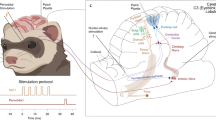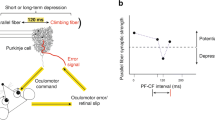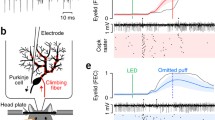Abstract
We use a mathematical model to investigate how climbing fiber-dependent plasticity at granule cell to Purkinje cell (gr→Pkj) synapses in the cerebellar cortex is influenced by the synaptic organization of the cerebellar-olivary system. Based on empirical studies, gr→Pkj synapses are assumed to decrease in strength when active during a climbing fiber input (LTD) and increase in strength when active without a climbing fiber input (LTP). Results suggest that the inhibition of climbing fibers by cerebellar output combines with LTD/P to self-regulate spontaneous climbing fiber activity to an equilibrium level at which LTP and LTD balance and the expected net change in gr→Pkj synaptic weights is zero. The synaptic weight vector is asymptotically confined to an equilibrium hyperplane defining the set of all possible combinations of synaptic weights consistent with climbing fiber equilibrium. Results also suggest restrictions on LTP/D at gr→Pkj synapses required to produce synaptic weights that do not drift spontaneously.
Similar content being viewed by others
References
Akshoomoff NA, Courchense E (1992) A new role for the cerebellum in cognitive processes. Behav. Neurosci. 106:731-738.
Albus JS (1971) A theory of cerebellar function. Math. Biosci. 10:25-61.
Anderson G, Garwicz M, Hesslow G (1988) Evidence for GABA-mediated cerebellar inhibition of the inferior olive in the cat. Brain Res. 472:450-456.
Angaut P, Sotelo C (1989) Synaptology of the cerebello-olivary pathway: doubling labeling with anterograde axonal tracing and GABA immunocytochemistry in the rat. Brain Res. 479:361-365.
Armstrong DM, Harvey RJ, Schild RF (1974). Topographical localization in the olivo-cerebellar projection: an electrophysiological study in the cat. J. Comp. Neurol. 154:287-302.
Armstrong DM, Rawson JA (1979) Activity patterns of cerebellar cortical neurones and climbing fibre afferents in the awake cat. J. Physiol. 289:425-448.
Artola A, Bröcher S, Singer W (1990) Different voltage-dependent thresholds for inducing long-term depression and long-term potentiation in slices of rat visual cortex. Nature 347:69-72.
Bloedel JR, Bracha V, Kelly TM, Wu J (1991) Substrates for motor learning: does the cerebellum do it all? Ann. N.Y. Acad. Sci. 627:305-18.
Braitenberg V (1967) Is the cerebellar cortex a biological clock in the millisecond range? Prog. Brain Res. 25:334-336.
Bullock D, Fiala J, Grossberg S (1994) A neural model of timed response learning in the cerebellum. Neural Networks 7:1101-1114.
Demer JL, Echelman DA, Robinson DA (1985) Effects of electrical stimulation and reversible lesions of the olivocerebellar pathway on Purkinje cell activity in the flocculus of the cat. Brain Res. 346:22-31.
De Schutter E (1995) Cerebellar long-term depression might normalize excitation of Purkinje cells: a hypothesis. Trends Neurosci. 18:291-95.
de Zeeuw CI, Holstege JC, Ruigrok TJ, Voogd J (1989) Ultrastructural study of the GABAergic, cerebellar, and mesodiencephalic innervation of the cat medial accessory olive: anterograde tracing combined with immunocyochemistry. J. Comp. Neurol. 284:12-35.
Dudek SM, Bear MF (1993) Bidirectional long-term modification of synaptic effectiveness in the adult and immature hippocampus. J. Neurosci. 13:2910-2918.
Eccles JC (1973) The cerebellum as a computer: patterns in time and space. J. Physiol. 229:1-32.
Eccles JC, Ito M, Szentágotai J (1967) The Cerebellum as a Neuronal Machine. Springer-Verlag, New York.
Ekerot CF, Kano M (1985) Long-term depression of parallel fibre synapses following stimulation of climbing fibres. Brain Res. 342:357-360.
Ekerot CF, Oscarsson O (1981) Prolonged depolarization elicited in Purkinje cell dendrites by climbing fibre impulses in the cat. J. Physiol. 318:207-221.
Fujita M (1982) Adaptive filter model of the cerebellum. Biol. Cybern. 45:195-206.
Gao JH, Parsons LM, Bower JM, Xiong J, Li J, Fox PT (1996) Cerebellum implicated in sensory acquisition and discrimination rather than motor control. Science 272:545-47.
Gellman RS, Gibson AR, Houk JC (1985) Inferior olivary neurons in the awake cat: detection of contact and passive body displacement. J. Neurophysiol. 54:40-60.
Gilbert PFC (1974) A theory of memory that explains the structure and function of the cerebellum. Brain Res. 70:1-18.
Gilbert PFC (1975) How the cerebellum could memorize movements. Nature 254:688-689.
Gonshor A, Melville-Jones G (1973) Changes in human vestibulo-ocular response induced by vision-reversal during head rotation. J. Physiol. (London) 234:102-103.
Groenewegen HJ, Voogd J (1977) The parasagittal zonation within the olivocerebellar projection. I. Climbing fiber distribution in the vermis of cat cerebellum. J. Comp. Neurol. 174:417-488.
Groenewegen HJ, Voogd J, Freedman SL (1979) The parasagittal zonation within the olivocerebellar projection. II. Climbing fiber distribution in the intermediate and hemispheric parts of cat cerebellum. J. Comp. Neurol. 183:551-602.
Hirano T (1990) Depression and potentiation of the synaptic transmission between a granule cell and Purkinje cell in rat cerebellar culture. Neurosci. Lett. 119:141-144.
Houk JC, Gibson AR (1986) Sensorimotor processing through the cerebellum. In: JS King, J Courville, ed. New Concepts in Cerebellar Neurobiology. Lissman, New York, pp. 387-416.
Ito M (1982) Cerebellar control of the vestibulo-ocular reflex: around the flocculus hypothesis. Ann. Rev. Neurosci. 12:85-102.
Ito, M(1984) The Cerebellum and Neural Control. Raven Press, New York.
Ito M (1989) Long-term depression. Ann. Rev. Neurosci. 12:85-102.
Ito M, Kano M (1982) Long-lasting depression of parallel fiber-Purkinje cell transmission induced by conjunctive stimulation of parallel fibers and climbing fibers in the cerebellar cortex. Neurosci. Lett. 33:253-258.
Ivry R (1993) Cerebellar involvement in the explicit representation of temporal information. Ann. N.Y. Acad. Sci. 682:214-230.
Keating JG, Thach WT (1995) Nonclock behavior of inferior olive neurons: interspike interval of Purkinje cell complex spike discharge in the awake behaving monkey is random. J. Neurophysiol. 73:1329-1340.
Keele SW, Ivry R (1990) Does the cerebellum provide a common computation for diverse tasks? a timing hypothesis. Ann. NY Acad. Sci. 608:179-207.
Kenyon GT, Medina JF, Mauk MD (1998) A mathematical model of the cerebellar-olivary system. II: Motor adaptation through systematic disruption of climbing fiber equilibrium. J. Comput. Neurosci. 5:71-90.
Leiner HC, Leiner AL, Dow RS (1993) Cognitive and language functions of the human cerebellum. Trends Neurosci. 16:444-447.
Linden DJ, Dickenson MH, Smeyne M, Connor JA (1991) A long-term depression of AMPA currents in cultured cerebellar Purkinje neurons. Neuron 7:81-89.
Lisberger SG (1988) The neural basis for learning simple motor skills. Science 242:728-735.
Llinas R, Walton K (1979) Place of the cerebellum in motor learning. In: MAB Brazier, ed. Brain Mechanisms of Memory and Learning. Raven Press, New York, pp. 17-36.
Llinas R, Welsh JP (1993) On the cerebellum and motor learning. Curr. Opin. Neurobiol. 3:958-968.
Marr D (1969) A theory of cerebellar cortex. J. Physiol. 202:437-470.
Mauk MD (1997) Relative contributions of cerebellar cortex and nuclei to motor learning: contradictions or clues? Neuron. 18:343-346.
Mauk MD, Donegan NH (1997) A model of Pavlovian eyelid conditioning based on the synaptic organization of the cerebellum. Learn. and Mem. 4:130-158
Mauk MD, Kenyon GT (1993) A stochastic model of cerebellar granule→Purkinje synapses (abstract). Soc. Neurosci. Abstr. 19:1609.
Medina JF, Mauk MD (1995) Stochastic simulations of cerebellar mediated motor adaptation (abstract). Soc. Neurosci. Abstr. 21:1222.
Montarolo PG, Palestini M, Strata P (1982) The inhibitory effect of the olivocerebellar input on the cerebellar Purkinje cells in the rat. J. Physiol. 332:187-202.
Mulkey RM, Malenka RC (1992) Mechanisms underlying induction of homosynaptic long-term depression in area CA1 of the hippocampus. Neuron. 9:967-975.
Oscarsson O (1980) Functional organization of olivary projection to the cerebellar anterior lobe. In: J Courville, C de Montigny, Y Lamarre, ed. The Inferior Olivary Nucleus: Anatomy and Physiology. Raven, New York, pp. 279-289.
Pellionisz A, Llinas R (1979) Brain modeling by tensor network theory and computer simulation: the cerebellum-distributed processor for predictive coordination. Neurosci. 4, 323-348.
Pellionisz A, Llinas R (1980) Tensorial approach to the geometry of brain function: cerebellar coordination via a metric tensor. Neurosci. 5, 1125-1136.
Raymond JL, Lisberger SG, Mauk MD (1996) The cerebellum: a neuronal learning machine? Science 272:1126-1131.
Ruigrok TJ, Voogd J (1990) Cerebellar nucleo-olivary projections in the rat: an anterograde tracing study with Phaseolus vulgaris-leucoagglutinin (PHA-L). J. Comp. Neurol. 298:315-333.
Sakurai M (1987) Synaptic modification of parallel fibre-Purkinje cell transmission in in vitroguinea-pig cerebellar slices. J. Physiol. (London) 394:463-480.
Sakurai M (1989) Depression and potentiation of parallel fiber-Purkinje cell transmission in in vitrocerebellar slices. In: P Strata, ed. The Olivocerebellar System in Motor Control. Springer-Verlag, New York, vol. 17, pp. 221-230.
Salin PA, Malenka RC, Nicoll RA (1996) Cyclic AMP mediates a presynaptic form of LTP at cerebellar parallel fiber synapses. Neuron. 16:797-803.
Schreurs BG, Alkon DL (1993) Rabbit cerebellar slice analysis of long-term depression and its role in classical conditioning. Brain Res. 631:235-240.
Sears LL, Steinmetz JE (1991) Dorsal accessory inferior olive activity diminishes during acquisition of the rabbit classically conditioned eyelid response. Brain Res. 545:114-122.
Sejnowski TJ (1977) Storing covariance with nonlinearly interacting neurons. J. Math. Biol. 4:303-321.
Shibuki K, Okada D (1992) Cerebellar long-term potentiation under suppressed postsynaptic Ca2+ activity. Neuro Report 3:231-234.
Tank DW, Sugimori M, Connor JA, Llinas RR (1988) Spatially resolved calcium dynamics of mammalian Purkinje cells in cerebellar slice. Science 242:773-777.
Thach WT (1980) Complex spikes, the inferior olive, and natural behavior. In: J Courville, C de Montigny, Y Lamarre, ed. The Inferior Olivary Nucleus: Anatomy and Physiology. Raven Press, New York, pp. 349-360.
Thach WT, Goodkin JP, Keating JG (1992) Cerebellum and the adaptive coordination of movement. Ann. Rev. Neurosci. 15:403-442.
Thompson RF (1986) The neurobiology of learning and memory. Science 233:941-947.
Watanabe E (1984) Neuronal events correlated with long-term adaptation of the horizontal vestibulo-ocular reflex in the primate flocculus. Brain Res. 297(1):169-174.
Weiss C, Houk JC, Gibson AR (1990) Inhibition of sensory responses of cat inferior olive neurons produced by stimulation of red nucleus. J. Neurophysiol. 64:1170-85.
Welsh JP, Harvey JA (1992) The role of the cerebellum in voluntary and reflexive movements: history and current status. In: R Llinas, C Sotelo, ed. The Cerebellum Revisited. Springer-Verlag, New York, pp. 301-34.
Yu QX, Ebner TJ, Bloedel JR (1985) Electrophysiological study of the corticonuclear projection in the cat cerebellum. Brain Res. 327:121-134.
Author information
Authors and Affiliations
Rights and permissions
About this article
Cite this article
Kenyon, G.T., Medina, J.F. & Mauk, M.D. A Mathematical Model of the Cerebellar-Olivary System I: Self-Regulating Equilibrium of Climbing Fiber Activity. J Comput Neurosci 5, 17–33 (1998). https://doi.org/10.1023/A:1008874209991
Issue Date:
DOI: https://doi.org/10.1023/A:1008874209991




